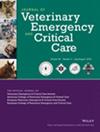Comparison of 4 point-of-care techniques to detect correct positioning of nasogastric tubes in dogs (2020–2021)
Abstract
Objective
To compare 4 point-of-care (POC) techniques to assess nasogastric (NG) tube placement versus radiographs as a reference standard. POC methods included air inflation with auscultation, fluid aspiration with pH measurement, ultrasonography, and capnography.
Design
Prospective observational study in hospitalized dogs between 2020 and 2021.
Setting
University teaching hospital.
Animals
Fifty-one dogs requiring NG tube placement as part of their normal care.
Interventions
After standard blind NG tube placement, each POC method was performed following standardized instructions. All POC methods were scored as to whether the investigator believed the tube to be in the gastrointestinal tract (as indicated by positive auscultation of borborygmus during insufflation, positive fluid aspiration with pH ≤5, presence of hyperechoic shadow in the esophagus, or absence of capnographic waveform). Subsequently, radiographs were taken to determine NG tube position as a gold standard. The sensitivity, specificity, and accuracy of each test as compared to 2-view thoracic radiographs were determined.
Measurements and Main Results
Sensitivity, specificity, and accuracy for each POC technique were as follows: air auscultation (84.4%, 50.5%, and 80.4%, respectively), neck ultrasound (95.6%, 83.3%, and 94.1%, respectively), capnography (91.1%, 33.3%, and 84.3%, respectively), and fluid aspiration with pH measurement (22.2%, 100%, and 31.4%, respectively).
Conclusions
Among the 4 techniques evaluated, neck ultrasound had the best overall performance for assessing NG tube placement. Fluid aspiration with pH measurement might also have potential due to perfect specificity, but its clinical utility may be limited by low sensitivity and accuracy. Nonetheless, 2-view thoracic radiography should still be considered the standard method for confirmation of NG tube placement as none of the 4 POC techniques investigated showed both high sensitivity and perfect specificity.

 求助内容:
求助内容: 应助结果提醒方式:
应助结果提醒方式:


